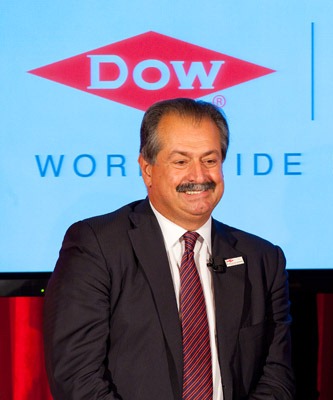Chem Giant Planning for Growth in 2015
“We believe lower oil prices are a relative positive for Dow and a boost for the global economy.”
“The old view of forecasting five years out almost seems to be out the door.”
Following the company’s 2014 earnings release—the Dow Chemical Company (ticker: DOW) posted EPS of $3.11 for the year, a 25% increase over 2013, and EBITDA of $9.3 billion, up almost $1 billion from last year—during yesterday’s Q4 earnings call, Dow Chairman and CEO Andrew Liveris and CFO Howard Ungerleider discussed the effect of falling oil prices on the chemical giant’s business sectors and offered projections for 2015.

“Let me be clear: I’m not here to state that there will be no challenges from lower oil; however, we believe the energy supply dynamic that is ongoing will lead to a long-term lower volatility scenario for our underlying structural positions. The long-term lower volatility of both oil and natural gas will reduce cyclicality of what have been historically cyclical businesses … .”
The Dow chairman/CEO and CFO addressed a plethora of commodities related questions from analysts during the Q&A:
As to the challenges from dropping oil prices and customer destocking:
“We obviously watch this very closely. We have our weekly meetings and our product managers and marketing managers, geographic managers. We clearly were watching for customer buying behavior as low oil kept occurring through the quarter. And yes, there were some – I actually mentioned it on TV today – there were some delays in purchasing, but it wasn’t due to demand destruction. People were just anticipating lower prices. We’re seeing January orders in line with our expected growth. Demand for February is firming as we enter the month. We believe inventories in the industrial engines are at lows, and this is basically pent-up demand based on the view that prices could drop even further.”
What are your thoughts on how the impact of oil might compress plastics margins?
“I would say clearly in the natural gas liquid world, so the North America world and the Middle East, you’re going to see margins decline. And we saw some of that happen in the fourth quarter for sure and the pressure is going to continue into 2015. But remember the naphtha world – we have our European assets as well as our Asian joint ventures, and even in Latin America we’re doing very well and we saw margins expand as well as demand strength in both Latin America as well as significant strength even in the fourth quarter in Europe.
“Remember, 2015 with demand growth still there as … as you get into the back half of this year, we believe low oil price is very good for world demand. And as you get global growth coming back through low oil prices you’ll start to see the beginning of peak economics in the Plastics engine going into 2016 and 2017. So we do believe with tight operating rates there’s a lot of operating leverage here and our value-add strategy actually gives us margin that we just don’t get on the feed stock, we get it in the packaging, elastomers and E&T business.
“So we have an ability to go after earnings growth independent of commodity environments. We’re not a commodity company, but we use commodity inputs to add value. I think what you’ll see from us, a continual drumbeat. We will have margin pressure across some of the portfolio based on low oil price. In the back half of this year, as demand gets tighter, I think we have an opportunity to certainly match last year’s performance.”
On Sadara [Saudi Aramco JV], at the current oil price, what’s the impact on the $0.5 billion of equity earnings you put out there for Sadara longer term by 2018?
“Look, the old view of forecasting five years out almost seems to be out the door. We couldn’t forecast, all of us, a year ago what would happen to oil today, right? So it’s a very hesitant forecaster here that talks about the impact on Sadara. Just remember that Sadara is more than just a gas cracker, ethane cracker. It’s a mixed feeds cracker that also uses other refinery streams from Aramco, not just naphtha, so please remember we’ve got ways to get from here to there even in a low oil environment.”
“I would also add – this is Howard – that that $500 million was a 10-year average run rate over the first 10 years. So we’re not stepping away from that number.”
We’ve had this reset of oil prices, I think you’ve rightly bragged about your operating rates, but as an industry if we look over the next year for those crackers that weren’t advantaged on U.S. ethane, do you think the margin structure for the non-U.S. ethane crackers of the world will be higher over the next year than it’s been in the past year, or do you think the depressed oil price will just flow through to the customers ultimately?
“We don’t believe so. We believe that there’s apples and oranges in a question like that. You’ve got to go through cracker by cracker. Restarting a cracker that’s based on naphtha just because of this current oil price naphtha scenario is not a given. In fact, we don’t believe many of them will restart at all. To restart an idle cracker takes a lot of money, and it’s a big bet in this sort of environment. So we believe supply tightness is in our imminent future. Operating rates are high across the entire Plastics chain. Those that are advantaged – remember Bob, 70% of our cracker fleet is in advantaged jurisdictions under oil – all oil and gas scenarios, and we’re flexible. So we’re advantaged even in disadvantaged regions like Europe. And in fact we’ve had margin expansion in Europe based on our ability to be cracking propane there, and that’s also true in North America. So we really believe that what’s going on out here is a net positive, and you’re seeing it in our operating rates, you’re seeing it in our leverage. We’ve returned to operating rates as a company that we had in 2007. How we’ve done that, we’ve taken out low-end assets. We’ve taken out uncompetitive assets and the rest of the industry’s done the same. So we believe that this is all tailwind as you get into the back half of this year.”
“I would also add, just on Andrew’s propane or LPG point, rather, in Europe we’ve improved that capability from the low-40% range to mid-50s, around 55% in Europe. And in North America, I mean from a propane standpoint, we do have the most feedstock flexible propane cracking of anyone else in the industry.”
It seems like you got a big benefit from lower energy complex in some of your specialties. So is there a giveback this year? Meaning if the specialty complex declines with a lag in the first half?
“Well, …the portfolio we’ve built has obviously lower input prices and as you go through the propane point is the great example of that, with flexibility, we can take advantage of any input, no matter what the situation is, whether it’s naphtha, whether it’s refinery related streams, propane or ethane.
“But your main point is we have a portfolio that’s doing value-add and the value-add in our strategy, we’ve been saying this over and over, we don’t have your vanilla-grade plastics business. We have a plastics business that has packaging value-add; elastomer value-add; E&T, electrical and telecommunications, value-add. We make money in that part of the chain and that’s a specialty lag effect, if you like, because those customers aren’t asking for the price decrease at the pace of the feedstock decrease because they don’t see the correlation. But that’s especially true in electronic materials, in our water business, in some of our more downstream businesses in building construction. So that is the portfolio we’ve built. We think we have, in essence, an opportunity here versus a challenge. Everyone else that’s more exposed to the price effect will have margin challenges. We are not that type of company because of the portfolio we have built. We have exited commodity businesses that had that volatility effect. So there is a dampened effect in our specialties portfolio, which is two-thirds of the company, and it’s integrated to the low cost feedstocks, so it’s a win-win for us.”
Could you update us on your view on supply of natural gas liquids in the U.S., in the new oil price environment?
“Ethane rejection economics are playing in the wet fields and certainly the NGL production at $3 gas is much more economic for those guys who are producing wet gas. So you’re going to keep getting production of ethane and propane as it applies. So that’s all advantaged the guys like us who are buying. We don’t see that changing any time soon, independent of the oil price.
“Clearly the oil price has had an effect on new rigs and new rig counts, and that’s all dropped off, well reported. And clearly if you’ve got dry gas you’ve been shut in for a while, so that doesn’t help you all that much. But as you know, it’s your question that plays here. And NGLs continue to be rejected but are still the most profitable part of the producers of wet gas.”
On the NGL side, you’ve stated in past presentations that you can go up to 60% propane, or 55%, and a similar number on LPG in Europe. But what is a realistic number, and is there anything that precludes you from getting that high? Is there enough supply in those regions to actually get to 60% or you’ll be cracking 30%, 35%?
“In essence what the whole strategy is, is we look at our furnace crack on a daily basis and we pivot around appropriately where we have the flex capability. So nothing stops us from taking it to those numbers. … In Europe we continue to expand our capability to crack LPGs, both propane and butane, and then the length of the season where propane is much cheaper than naphtha continues to grow as U.S. continues to expand more and more LPG. So U.S. LPG expansions help Europe and they also firm price in the U.S. which helps production in the U.S., and so it’s a double win for us and strategically, structurally helps us.”
Specific to the U.S. side of things, obviously the market’s a bit fearful that ethane-based margins have come down, call it $0.06, $0.07 a pound relative to 2014 averages. But if I take a look at U.S. propane-based ethylene margins, they’re actually up, even sort of higher than where ethane-based margins were last year. So my question is how high could you take your propane bias in the U.S.? And could you actually come up with a scenario that if we were to mark everything to market to current pricing, year-on-year we could actually have higher margins this year than last year?
“Well, firstly, we can go up to 70% of our crack slate here in the U.S. So if you look at the propane dynamic you just talked about, then clearly there’s a scenario here that has us not feeling the effect of the oil to gas or naphtha to ethane arbitrage as much as others. That clearly is further enhanced by propane dehydrogenation, as I’ve already implied in my script. I’m not going to foreshadow – I’ll repeat in our Plastics record profits last year and frankly, the year before, they’ve been expanding profits quite considerably but our feedstock flex, as propylene weakens there could be some effect of margins coming down on some of our businesses. But as far as Polyethylene and Plastics is concerned and mark-to-market, advantage Dow on propane crack.”
We’ve begun to hear about some project cancellations. I know you talked about on the Dow side of things the projects being on track and the like, but recently we heard about a Shell project cancellation out in Qatar, and recently Sasol canceling one of their GTL facilities. What’s your view about some of these newer greenfield ethylene facilities in the U.S.? Do you think there will be more cancellations going forward? And part and parcel with that, where do you stand today in terms of your cycle view?
“Second question first. So we haven’t changed our view on the cycle. And since low oil started last quarter, we’ve been very clear that we think ultimately six to nine months out, low oil price foreshadows increased demand, so this should help the world economy, not hurt it. Which I know is a view that not many others talk about, but I think our results should show that. So we don’t have to talk about it, we can just show our results. So that then says demand is there. Operating leverage is there, to Bob Koort’s earlier question, so then you see the cycle playing out in 2016, 2017, with the back half of this year creating further tightening opportunities based on demand.
“In terms of supply, we don’t think any of the big ethane crack projects will be affected. I think those economics are still sound based on excess NGLs as per an earlier question I got. I do think, as you’re seeing with some of the projects, even the one yesterday on Sasol GTL, anything oil-related, anything directly connected to the oil molecule will definitely be delayed. We’re seeing a ton of those being delayed. But that’s less about what the U.S. projects will do. I think those U.S. projects – the ones that we’ve all foreshadowed, the 2017, 2018 start-ups will be relatively unaffected.”
So looking back historically, when we saw big commodity moves down and/or oil prices move down, there was the benefit of pretty significant working capital benefits for you in the past. But admittedly, most of those were during weak economic periods. We don’t have that this time around. So I guess how are you thinking about the potential for working capital to really drive significant cash flow for you in 2015?
“Overall it should be a nice tailwind to our cash flow, and I think you started to see that show already in the fourth quarter. We’re working not only on the raw material or the price cost side of the equation but also on the volume unit side with our efficiency programs. So our DSI was down by four days in the fourth quarter versus the third quarter. 60% of that drop was volume and 40% of that was based on price cost. So it will be a tailwind in 2015.”
With regard to the run rate EBITDA for the projects coming up in 2015, looks like they’ve been tweaked a little bit lower from the investor day. Is that an oil reflection? Are you kind of marking things to the market right now, or do you have other assumptions that maybe we should think about in those numbers?
“I don’t think we’ve actually come off in terms of our public position on any of those projects. I mean, I think if you look at where the specific margins were in the fall, they’ve come off a bit just from a market standpoint but they’re still well above what we originally laid out. So the PH unit of $450 million, you look at the implied spread on propane to propylene, that’s still well within our guidance that we’ve given.”
Back on the Pet Chem side, if we remain in this type of an oil environment throughout the year, do you think the more marginal production in Asia is MTO-based or would it be naphtha based the way you would look at it?
“Firstly, there’s a whole scenario around MTO not coming on at the pace anyone thinks it’s going to come on. I think there’s an oil recalibration going on because of oil and coal. Remember that methanol’s coming from coal. And so that’s going to change a lot in terms of when those projects come online. Which therefore defaults to your question being answered by saying it’s incremental naphtha. But I’ve already answered the previous question about there’s not many of that that’s going to come online. The way we view it is Asia’s going to stay high cost under any scenario. The beneficiary to this low oil scenario is mostly in Europe, especially those that can take NGL crack by propane.”
2015?
“2015 will be a major milestone year for Dow with the startup of several of our major investments. … Our projects on the U.S. Gulf Coast and the Middle East remain on schedule. Sadara will establish a foundation that we will leverage to compete in the Asian and Middle Eastern markets for the next many decades. Overall construction is approximately 85% complete with construction for first product assets in the polyolefin value chain approximately 95% complete.
“Falling propylene prices in the United States are improving the competitiveness of our U.S.-based propylene derivative businesses, while at the same time expanding our integration advantage in our market facing businesses. Our new PDH unit comes on-stream in the second half of 2015, capturing the propane to propylene spread for one-third of Dow’s U.S. propylene needs, expanding the earnings power of Dow’s integrated business model.”
Important disclosures: The information provided herein is believed to be reliable; however, EnerCom, Inc. makes no representation or warranty as to its completeness or accuracy. EnerCom’s conclusions are based upon information gathered from sources deemed to be reliable. This note is not intended as an offer or solicitation for the purchase or sale of any security or financial instrument of any company mentioned in this note. This note was prepared for general circulation and does not provide investment recommendations specific to individual investors. All readers of the note must make their own investment decisions based upon their specific investment objectives and financial situation utilizing their own financial advisors as they deem necessary. Investors should consider a company’s entire financial and operational structure in making any investment decisions. Past performance of any company discussed in this note should not be taken as an indication or guarantee of future results. EnerCom is a multi-disciplined management consulting services firm that regularly intends to seek business, or currently may be undertaking business, with companies covered on Oil & Gas 360®, and thereby seeks to receive compensation from these companies for its services. In addition, EnerCom, or its principals or employees, may have an economic interest in any of these companies. As a result, readers of EnerCom’s Oil & Gas 360® should be aware that the firm may have a conflict of interest that could affect the objectivity of this note. The company or companies covered in this note did not review the note prior to publication. EnerCom, or its principals or employees, may have an economic interest in any of the companies covered in this report or on Oil & Gas 360®. As a result, readers of EnerCom’s reports or Oil & Gas 360® should be aware that the firm may have a conflict of interest that could affect the objectivity of this report.







